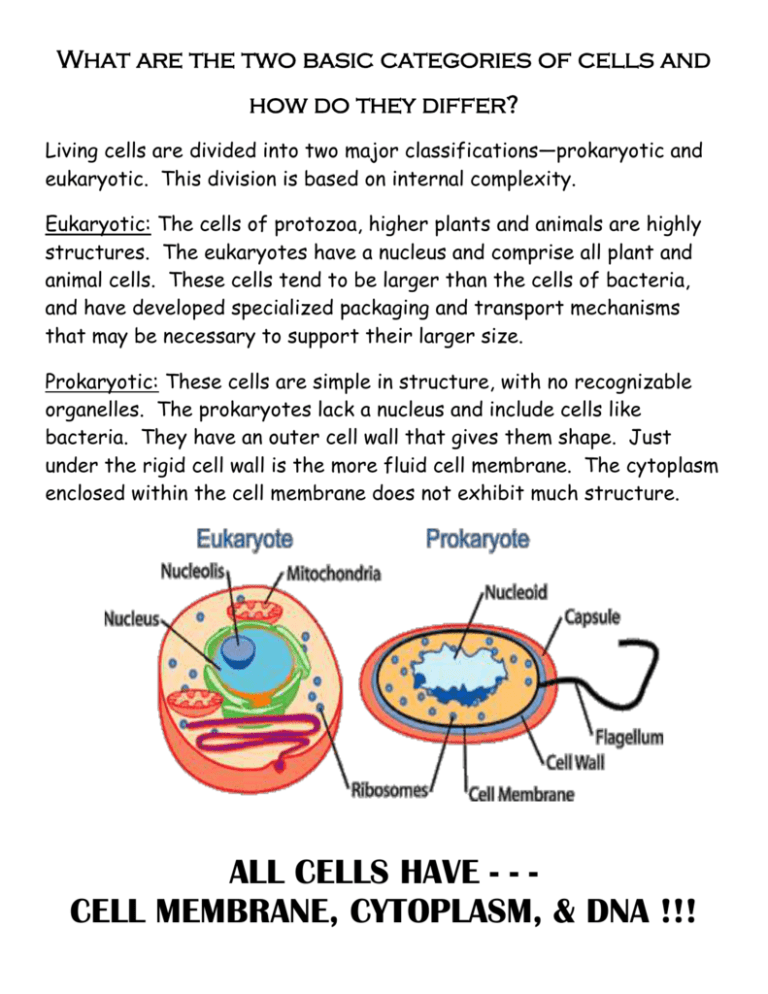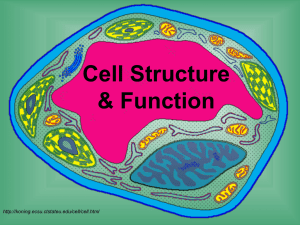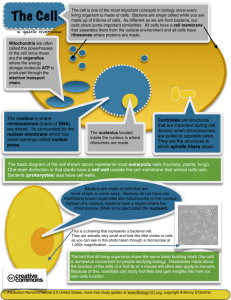What are the two basic categories of cells and
advertisement

What are the two basic categories of cells and how do they differ? Living cells are divided into two major classifications—prokaryotic and eukaryotic. This division is based on internal complexity. Eukaryotic: The cells of protozoa, higher plants and animals are highly structures. The eukaryotes have a nucleus and comprise all plant and animal cells. These cells tend to be larger than the cells of bacteria, and have developed specialized packaging and transport mechanisms that may be necessary to support their larger size. Prokaryotic: These cells are simple in structure, with no recognizable organelles. The prokaryotes lack a nucleus and include cells like bacteria. They have an outer cell wall that gives them shape. Just under the rigid cell wall is the more fluid cell membrane. The cytoplasm enclosed within the cell membrane does not exhibit much structure. ALL CELLS HAVE - - CELL MEMBRANE, CYTOPLASM, & DNA !!! One major difference in cells occurs between plant cells and animal cells. Plant cells have some additional specialized structures. Many animals have skeletons to give their body structure and support. Plants do not have a skeleton for support because they have a unique cellular structure called the cell wall. The cell wall is a rigid structure outside of the cell membrane composed mainly of cellulose. The cell wall gives the plant cell a defined shape which helps support individual parts of plants. In addition to the cell wall, plant cells contain an organelle called the chloroplast. The chloroplasts allow plants to harvest energy from sunlight. Specialized pigments in the chloroplast (including the common green pigment chlorophyll) absorb sunlight and use this energy to complete the chemical reaction. In this way, plant cells manufacture glucose and other carbohydrates that they can store for later use. 6 CO2 + 6 H2O + energy (from sunlight) C6H12O6 + 6 O2 Prokaryote: cell without a nucleus Bacteria Eukaryote: cell with a nucleus Plant and Animal Producer (Autotroph): an organism that makes its own food Plants Consumer (Heterotroph): cannot make its own food Animals CELL NUCLEUS CELL CELL TYPE (P or E) WALL (Y/N) MEMBRANE (Y/N) BACTERIA PLANT ANIMAL ALL CELLS HAVE - - - CELL MEMBRANE, CYTOPLASM, & DNA !!! http://learn.genetics.utah.edu/content/begin/cells/insideacell/











